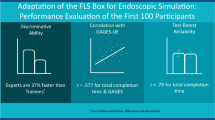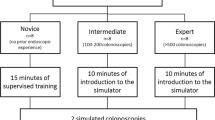Background
The hypothesis of this study is that working on the simulator without a structured feedback does not change performance; hence, any effects shown after structured feedback would amount to useful learning of the procedure. The aim was to investigate the learning curve for the HT Immersion Medical Colonoscopy Simulator without any structured feedback. This could then be potentially applied to validate the learning curve on the simulator when structured feedback is provided. There are no previous studies on this matter.
Methods
Candidates were asked to perform colonoscopy on the HT Immersion Medical Colonoscopy Simulator. Modules 3 and 4 were used at random. In total, each candidate was asked to perform five consecutive virtual colonoscopies on the same module. These five episodes were collectively referred to as one trial. A time result of 3,600 sec (1 h) was used to denote perforation. No guidance or feedback was given to candidates before, during, or after each procedure. A total of 26 postgraduate doctors were recruited, including nine research fellows, five preregistration house officers, six specialist registrars, and six consultants. Fourteen candidates recorded five attempts each (i.e., one trial each) on the same module of the colonoscopy simulator (14 trials over 70 episodes). Another 12 candidates recorded five attempts (i.e., one trial each) on two modules of the colonoscopy simulator (24 trials over 120 episodes). Hence, 190 episodes were recorded in total, representing 38 trials.
Results
There was no improvement in performance on the simulator from first attempt to the fifth in the absence of feedback. If there was any initial gain in any measurable outcome, this was lost in subsequent attempts indicating lack of learning. The outcomes measured included time taken to complete the test, percentage of the mucosa visualized, depth of the instrument inserted, and the path length used. The results were statistically significant for all outcomes.
Conclusions
This study demonstrates that in the absence of feedback, it is not possible to improve performance on the HT Immersion Medical Colonoscopy Simulator. Thus, there is no learning curve for the machine. The information from this study is vital for using the simulators in training and assessment because any improvement in learning curves shown after training on simulators can be presumed to be due to learning the procedure and not the simulator






Similar content being viewed by others
References
KC Calman JG Temple (1999) ArticleTitleReforming higher specialist training in the United Kingdom Med Education 33 28–33 Occurrence Handle10.1046/j.1365-2923.1999.00356.x Occurrence Handle1:STN:280:DyaK1M3islOhsg%3D%3D
A Chaudhry C Sutton (1999) ArticleTitleLearning rate for laparoscopic surgical skills on MST VR: quality of human computer interface Ann R Coll Surg Eng 81 281–286 Occurrence Handle1:STN:280:DC%2BD3c%2Fot1SlsQ%3D%3D
J Hochberg J Maiss B Magdeburg et al. (2001) ArticleTitleTraining simulators and education in gastrointestinal endoscopy: current status and perspectives in 2001 Endoscopy 33 541–549 Occurrence Handle10.1055/s-2001-14972 Occurrence Handle11437051
PO Katz (1995) ArticleTitleProviding feedback Gastrointestinal Endosc Clin North Am 5 347–355 Occurrence Handle1:STN:280:ByqA2cnhtlU%3D
T Mahmood A Darzi (2003) ArticleTitleThe colonoscopy simulator as a teaching tool Gut 52 262 Occurrence Handle10.1136/gut.52.1.34
T Mahmood A Darzi D Bouchier Hayes (2003) ArticleTitleIs the UK gastrointestinal endoscopy training adequate? The trainer and trainee’s perspective Gut 52 21 Occurrence Handle10.1136/gut.52.1.34
R Mallinson (2000) ArticleTitleTraining in sigmoidoscopy: the experience of trainees in elderly medicine in East Anglia Int J Clin Practice 54 265–266 Occurrence Handle1:STN:280:DC%2BD3cvhvVyisw%3D%3D
MV Sivak et al. (1995) ArticleTitleThe art of endoscopic instruction Gastrointest Endosc Clin North Am 5 299–310
MM Yeh DF Cahill (1999) ArticleTitleQuantifying physician teaching productivity using clinical relative value units J Gen Internal Med 14 617–621 Occurrence Handle10.1046/j.1525-1497.1999.01029.x Occurrence Handle1:STN:280:DC%2BD3c%2FktVymtw%3D%3D
Author information
Authors and Affiliations
Rights and permissions
About this article
Cite this article
Mahmood, T., Darzi, A. The learning curve for a colonoscopy simulator in the absence of any feedback: No feedback, no learning. Surg Endosc 18, 1224–1230 (2004). https://doi.org/10.1007/s00464-003-9143-4
Received:
Accepted:
Published:
Issue Date:
DOI: https://doi.org/10.1007/s00464-003-9143-4




